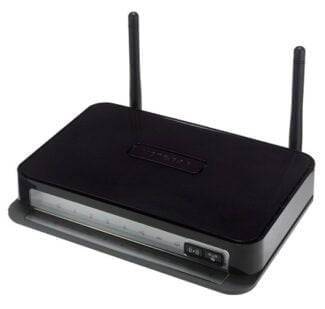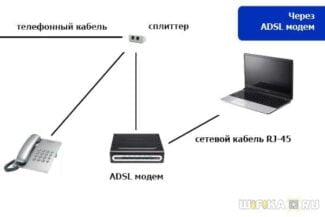TP-LINK TD-W8968 – relatively inexpensive, but quite high-quality ADSL router

- Rating of TOP 7 ADSL-modems with Wi-Fi: review and characteristics of the best models of 2023
- How to choose a ADSL modem?
- History of ADSL
- How ADSL works
- How ADSL differs from a regular router
- Top 4 ADSL routers
- TP-LINK Archer VR400 Wi-Fi Router
- Wi-Fi router Keenetic Duo (KN-2110)
- ASUS DSL-N16 Wi-Fi router
- FAQ
- What is the difference between a router and an ADSL router?
Rating of TOP 7 ADSL-modems with Wi-Fi: review and characteristics of the best models of 2023
ADSL modem is a device that provides an Internet connection through the telephone network. Today it is not the fastest way to access the Web, but today's standards allow for a much faster and more stable connection than in the early noughties.
A few decades ago, the Internet could only be connected if you had a home phone.
And you had to choose: either a telephone connection or the Internet.
Now technology has become much more accessible and comfortable: it is enough to wire Internet to your home device, buy a SIM-card with mobile Internet, or get a router with the ability to connect a modem, to always stay in touch.
One of the most modern technologies is ADSLwhich implies a different speed of incoming and outgoing data.
How to choose a ADSL modem?
For information! ADSL is an asymmetric digital subscriber line, in which the speed of receiving data exceeds the speed of data transmission.
In this case, the greater the distance from the telephone node, the slower the data exchange.
To access the network was comfortable, stable and fast, it is important to choose the right device to ensure signal quality.

To do this, it is enough to remember the basic selection criteria.

- Type of DSL technology.
There are ADSL, ADSL2 and ADSL2+ versions, and they differ in bandwidth.
The modem of the last type provides the speed of incoming traffic up to 24 Mbit/s, while the other two – up to 8 and 12 Mbit/s respectively. - Annex standards.
Annex A is the best – "pure" and supported by most providers.
Annex M is faster, but many ISPs do not support it.
Annex L has interference, but transmits well over long distances. - Availability of DHCP-server.
If there is a DHCP-server it is much easier to configure the device: you will not have to give IP-addresses to all local network users. - The way to connect to the device.
The Ethernet port provides a more stable connection without interference, while a modem with a USB connection is cheaper.
It is not as reliable and is only suitable if 1 gadget will be connected to the internet. - The number of LAN ports.
The more stationary devices you need to connect to the network, the more LAN ports are needed.
This is relevant for office systems, as at home you can connect via Wi-Fi. - Wireless standard.
The most popular and sought-after standard is 802.11n. - Wireless speed.
The classic option – 100 Mbps. - Type of antennas.
Antennas can be removable and non-removable.
The first option is preferable, because if necessary, you can replace the built-in models with more powerful ones.
History of ADSL
ADSL began to develop in the eighties. And its first direction of work was, oddly enough, interactive TV. In 1987 Bellcore introduced in USA the first technology of xDSL family, which provided a connection to TV through telephone lines. However, soon after that Bellcore broke up, and about xDSL all happily forgotten… until 1994. It was at this time came ADSL – asymmetric line. It developed very slowly, because its only purpose in the 90's was to transmit video with no outgoing traffic. But that all changed when the Internet came into the homes of everyday people. The first mass ISPs saw the possible benefits of using a seemingly forgotten technology. The main advantage for Internet providers turned out to be the cheapness of such a service. Although ADSL required the installation of additional hardware on each PBX of the provider, the principle of DSL itself was quite profitable, and the technology quickly paid for itself.
Over time, more high-speed data transfer technologies emerged – Ethernet, GPON, DOCSIS… Nowadays the first one is the most common in everyday life. But ADSL still holds a leading position in spite of the limited speed of receiving-transferring data. In ADSL2+, which is currently the latest standard, the incoming flow rate is limited to 24 Mbps.
By comparison, Fast Ethernet is up to 100 Mbps and Gigabit Ethernet is up to 1 Gbps.
Wikipedia
https://ru.wikipedia.org/wiki/ADSL
So why hasn't ADSL been forced out of the market yet? It's simple – it's very cheap and stable. That's why in situations where people need budget, quality and uninterrupted Internet access at medium speed, ADSL is the best choice.

How ADSL works
The abbreviation ADSL stands for Asymmetric Digital Subscriber Line, which in Russian sounds like "asymmetric digital subscriber line". Why asymmetric? Because the amount of outgoing traffic takes a smaller fraction of the bandwidth than incoming. This is easily explained by the fact that most users download more from the Internet than they upload to the network.
To connect to the network, ADSL uses a telephone line. In order not to interfere with the telephone itself the technology sets the lower frequency limit at 25 kHz. The phone, on the other hand, operates at frequencies of 0.2 to 3.5 kHz. Thus, there is no frequency crossover, and the Internet and telephone can quite easily coexist on the same line. So you don't have to be afraid that when you connect the Internet you will have no access to the phone, like in the early 2000s.
How ADSL differs from a regular router
What is the difference between a regular router, which is connected via Ethernet cable, and an ADSL device?
The task of a router is to receive the signal coming from an Ethernet cable (or a 3G/4G modem, which is not important to us right now) and distribute it further to all the devices connected to it in the same network. The modem receives the signal and then converts it so that the connected devices can use it.
However, nowadays there is a clear distinction between routers and modems – it is not uncommon to see routers with a modem function or, vice versa, modems with a router function. So in this article we're going to look at any device that can connect using ADSL technology, regardless of their classification.
Top 4 ADSL routers
TP-LINK Archer VR400 Wi-Fi Router
A powerful and versatile router that supports the ADSL2+ standard. In addition to it, Archer VR400 can be connected to a dedicated line via RJ-45 and even to a 3G/LTE modem via USB port. The device supports 802.11a/b/g/n/ac Wi-Fi with simultaneous operation in 2.4 and 5 GHz frequency bands. Three antennas and a powerful transmitter provide a wide coverage area and stable reception in all conditions.
The device price is about 6500 rubles. For such a functional solution is quite an affordable price.
Wi-Fi router Keenetic Duo (KN-2110)
Functional Wi-Fi router, which in addition to ADSL2 + supports, it seems, all existing standards and protocols for network connection and data protection. Dual band Wi-Fi up to 802.11a easily covers all your household needs and you have enough coverage even for a large apartment or office.
With a small discount, KN-2110 can be purchased for less than 4,500 rubles. Quite a bargain – and just a good balanced model without any serious drawbacks.
ASUS DSL-N16 Wi-Fi router
A good-looking and productive Wi-Fii-ADSL2+ router from a time-tested and trustworthy manufacturer. It can do everything that a decent wireless router should do.
The only disadvantage is the support of the outdated 802.11n Wi-Fi standard at up to 300 mbps and only in one 2.4 GHz band. On the other hand, these parameters are more than enough to cover the connection possibilities via ADSL, so I wouldn't pay too much attention to this point. Moreover, the DSL-N16 price is only a little over 3000 roubles.
FAQ
What is the difference between a router and an ADSL router?
Absolutely nothing. A "router" is one of the variants of the English word router translated into Russian. So router and router mean the same device.
Wi-Fi-ADSL2+ router; Wi-Fi standard: 802.11n; max speed: 300 Mbps; 4xLAN switch; VPN support.
Transmit power, Range; Wi-Fi-ADSL2+ router; Wi-Fi standard: 802.11n; max speed: 300 Mbps; support for optional 4G modem; 4xLAN switch.
Wi-Fi-ADSL2+ router; Wi-Fi standard: 802.11n; max speed: 300 Mbps; 4xLAN switch; 100 Mbps port speed.
Quality of communication; Wi-Fi-ADSL2+ router; Wi-Fi standard: 802.11n; max speed: 300 Mbps; 4xLAN switch; VPN support.
Wi-Fi-ADSL2+ router; Wi-Fi standard: 802.11n; max speed: 300 Mbps; 4xLAN switch; VPN support.
Wi-Fi-ADSL2+ router; Wi-Fi standard: 802.11n; max speed: 300 Mbps; 4xLAN switch; VPN support.
Wi-Fi-ADSL2+ router; Wi-Fi standard: 802.11n; max speed: 300 Mbps; 4xLAN switch; VPN support.
Wi-Fi-ADSL2+ router; Wi-Fi standard: 802.11n; max. speed: 300 Mbit/s; support optional 3G modem; 4xLAN switch.
Wi-Fi-ADSL2+ router; Wi-Fi standard: 802.11n; maximum speed: 300 Mbps; 4xLAN switch; VPN support.
Transmit power, Easy setup; Wi-Fi-ADSL2+ router; Wi-Fi standard: 802.11a/b/g/n/ac; max speed: 1167 Mbps; support for optional 4G modem; 4xLAN switch.
- Type of DSL technology.






